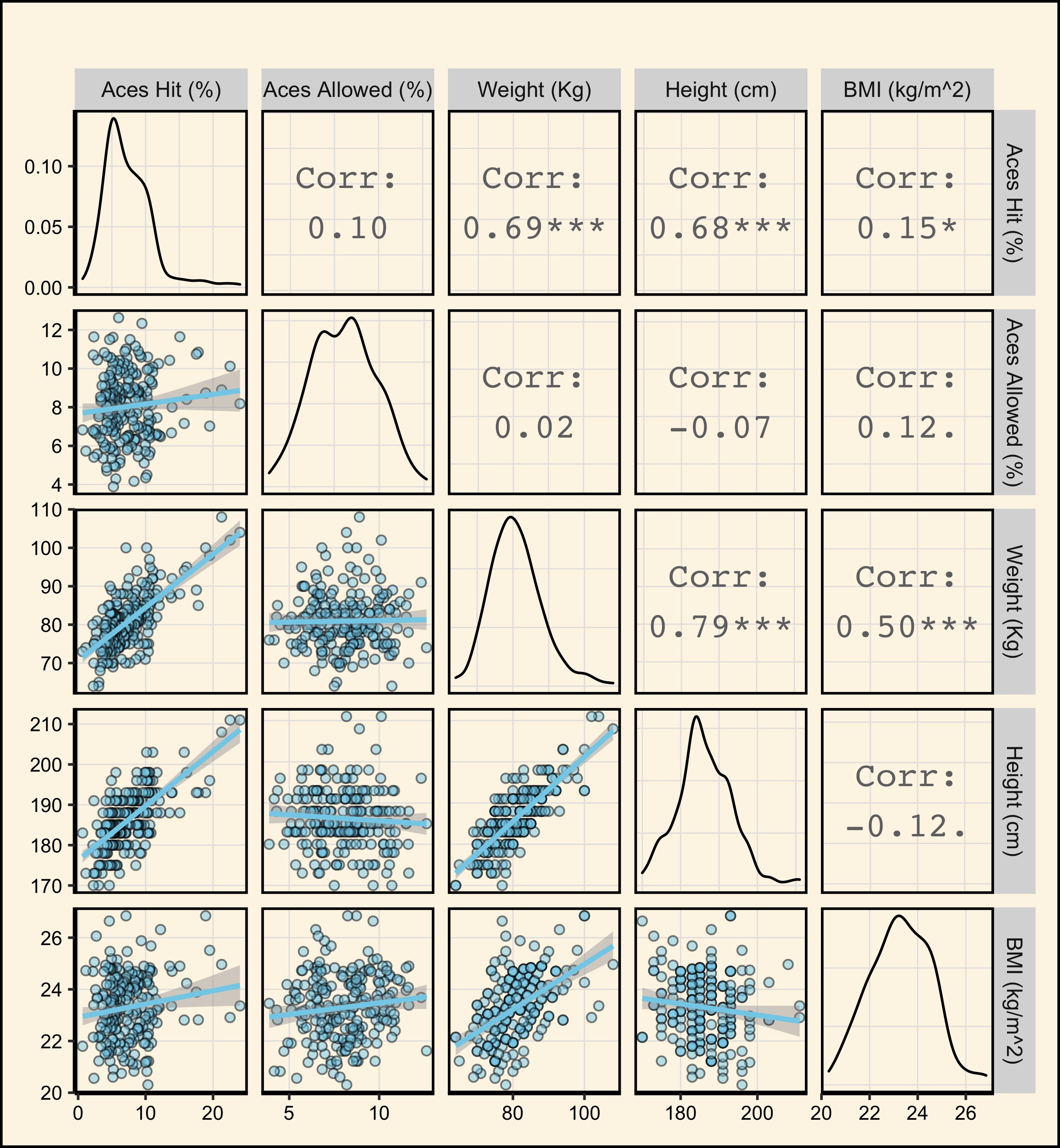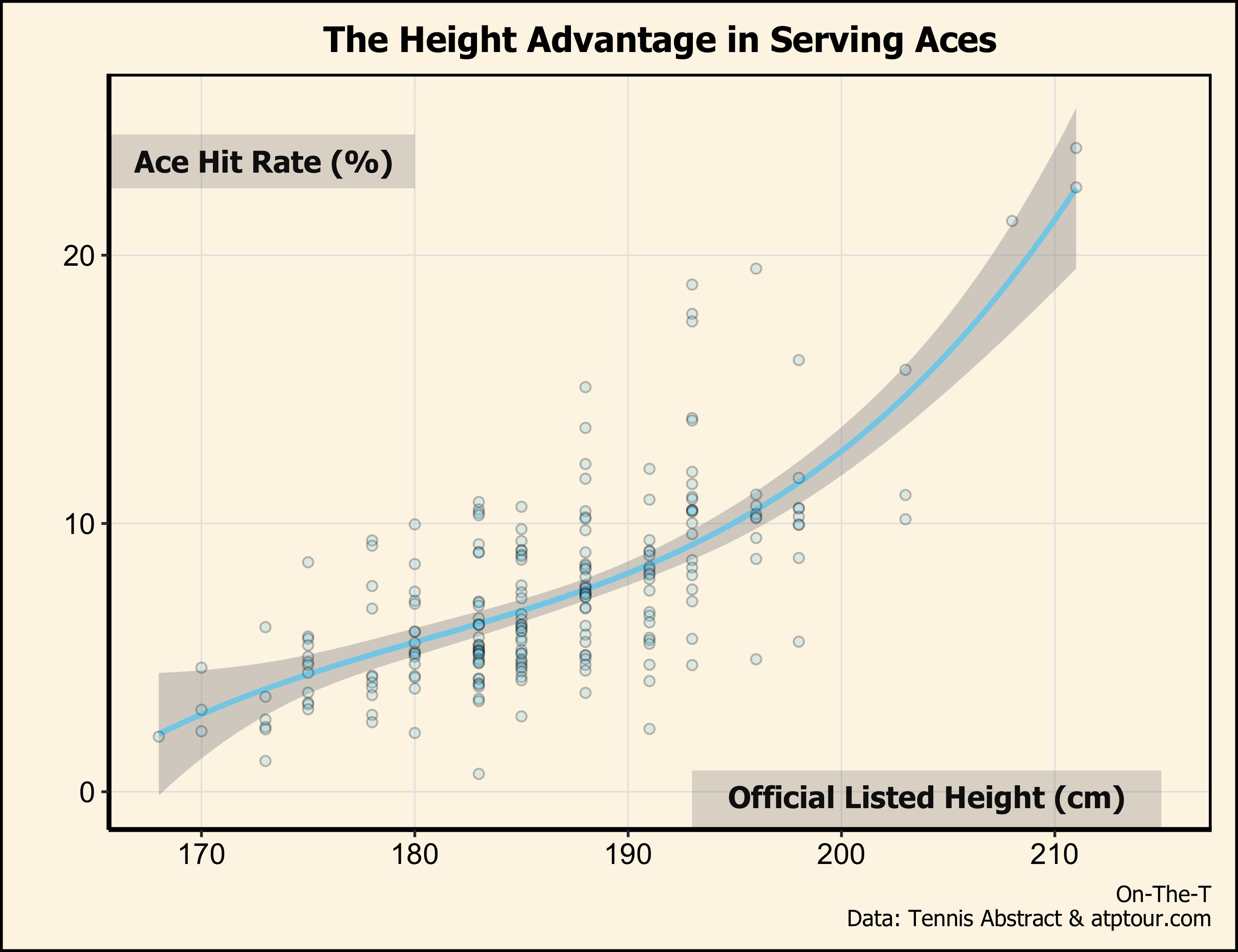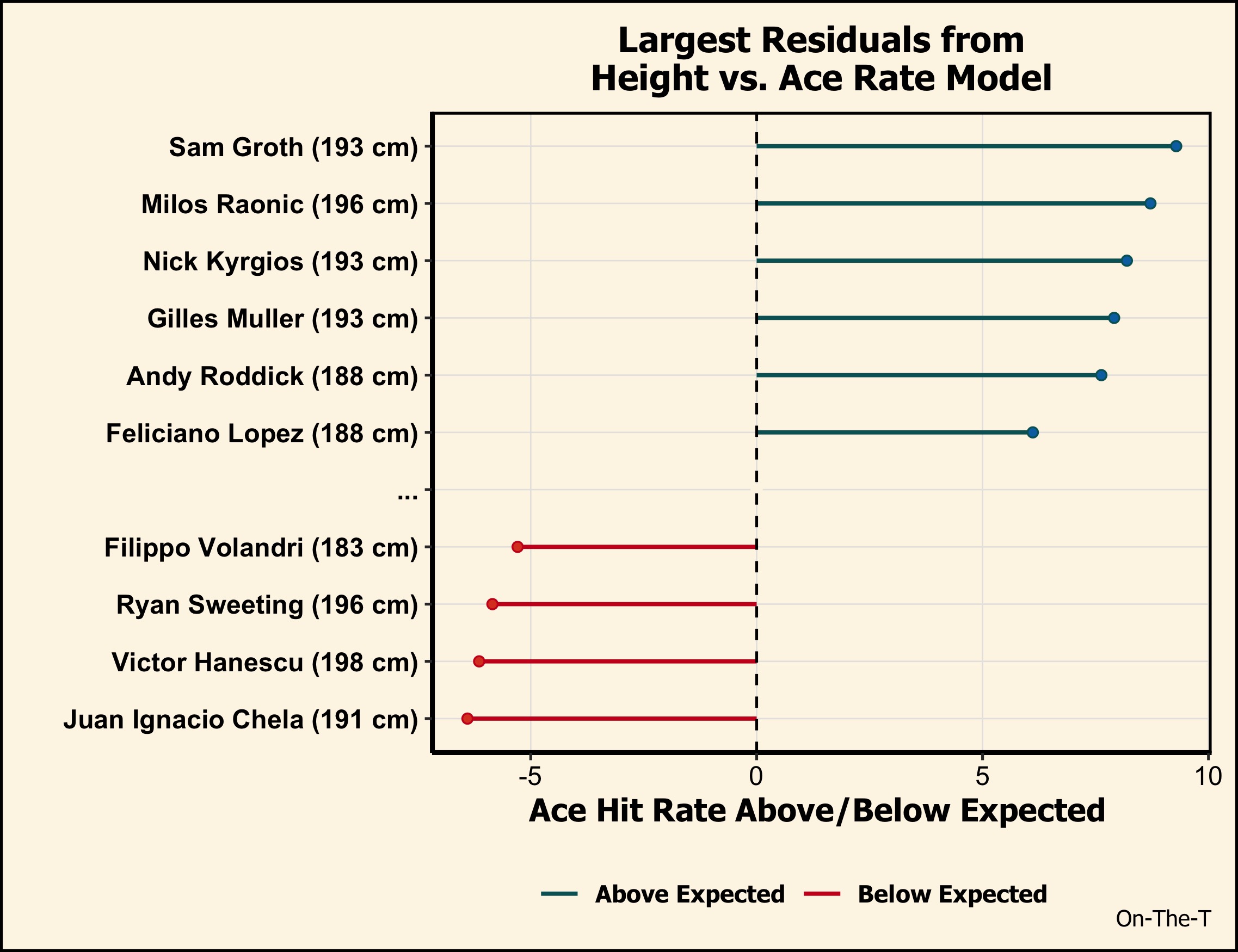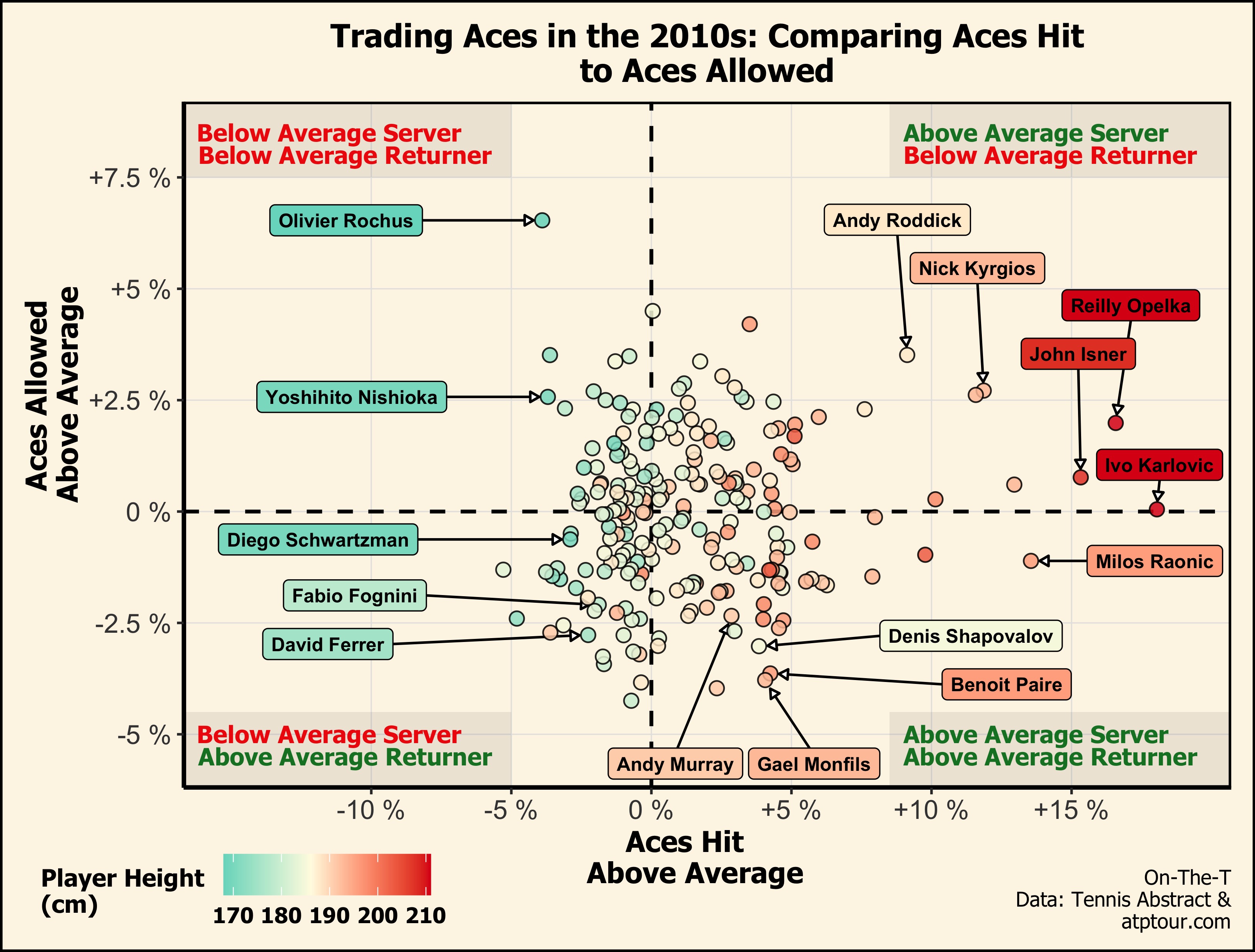Sizing Up the Height Advantage on Serve
Can you ever have too much height in tennis? In this post, Peter Tea analyzes two sides of the “big server” equation as he delves into the influence of height on the rate of aces hit and aces allowed among ATP players.
The serve is the only shot in tennis where a player has full command of the ball, including its speed, placement, and spin. Some treat the serve as a mere prerequisite to a rally, banking on their groundstrokes to win points. For others, the serve is their bread-and-butter. These players strike swiftly and play with the mindset that the fewer shots hit, the better.
What makes some players so dangerous on serve? Clearly, height is a major factor. Not only can taller players serve at higher speeds, but their higher vantage point also allows a larger margin for error to clear the net, and offers wider angles to target inside the service box. Despite the tension between speed and accuracy, where gains in one are often not possible without costs to the other, taller players would seem to have an advantage with both of these key properties of the serve. And this equates to more ‘free’ points for big servers.
There may be no limit to the gains in serve prowess with greater stature. But a towering frame must have significant downsides to other tennis skills, otherwise every top tennis player would have the build of Ivo Karlovic. It is often assumed that height diminishes mobility and makes it difficult for tall players to have a strong return game. It may be inarguable that a taller player will have less quickness and power in their lower body but the return game isn’t just a measure of lower body agility. As Wiley Reed describes in his analysis of player height for the Tennis Abstract, greater wing span could also help a receiver cover more space and act to counterbalance less agile lower body movement. Which all makes the cost to a big server’s return game less clear.
In this post, we will examine both sides of the big server coin— the offensive gains on serve and the defensive costs on the serve return. And we’ll see if there is any evidence that big servers may come up heads in both respects.
The analysis will focus on two ace metrics: Ace Hit Rate and Ace Allowed Rate. Aces are an extreme, but should, when averaged over many matches, summarize a player’s ability to attack with their serve and defend against their opponent’s serve, respectively.
Ace Hit Rate is defined as :
$$ \textrm{Ace Hit Rate} = \frac{\textrm{Total # Aces Hit}}{\textrm{Total # Serve Points}} \cdot 100 % $$
Similarly, the Ace Allowed Rate is:
$$ \textrm{Ace Allowed Rate} = \frac{\textrm{Opponents’ Total # Aces Hit}}{\textrm{Opponents’ Total # Serve Points}} \cdot 100 % $$
The Ace Allowed Rate is an unconventional measure. While Return Points Won (RPW) is the de facto measure of a player’s return ability, aces allowed is a more direct measure of a player’s reach on the serve return, which may be one aspect of receiving skill where height is an advantage. While reach may also be an advantage for rallying, because of the greater court coverage involved with shots after the serve return, leg movement and agility would become a greater factor for overall RPW .
Fig. 1 shows scatterplots of aces hit and aces allowed rates against player height, weight and body mass index (BMI), respectively. The data shown here are from matches in the 2010’s decade (i.e. 2010 - 2019). Ace data was obtained from Tennis Abstract, while player height and weight data were scraped from their official bios on atptour.com. Only male players who completed at least 50 matches in this decade were included in our study—221 players in total.

The strongest linear relationships between our anthropometric features and our two ace rates are between Height and Aces Hit, as well as Weight and Aces Hit. Considering BMI, there is a modest indication of a linear relationship with Ace Hit Rate. In particular, the upward trend we observe seems influenced by a small number of players with the most outlying ace rates.
This last observation is especially notable in light of a 2014 study evaluating body kinematics among elite players from Hong Kong. The authors found a significant linear association between BMI and serve speed and attributed their findings to the ability of players with higher BMI to more easily generate torque. The fact that we don’t observe the same finding in the population of ATP players may suggest that this study was underpowered or was not representative of top professional male players.
Interestingly, the rate of aces allowed did not correlate strongly with any of our anthropometric features. This would seem to suggest that diminished mobility may offset any advantage in reach tall players have, especially when chasing down opposition serves.
Zooming in closer on the scatter plot of Ace Hit Rate and player height, we noticed that this relationship might not be entirely linear. That is, Ace Hit Rate may not be increasing at the same rate for all heights. To account for a potential non-linear relationship, we fit a cubic regression curve outlined as follows:
$$ E[\mbox{Ace Hit Rate}] = B_0 + B_1 * \mbox{Height} + B_2 * \mbox{Height}^2 + B_3 * \mbox{Height}^3 $$
Other methods like LOESS and optimal smoothing splines were also considered, but did not offer significant improvement. While not an entirely perfect fit, our cubic regression model accounts for ~50% of the variance in Ace Hit Rate (Fig. 2). Factors that may contribute to the remaining unexplained variance could include serve technique and strategy. For example, players who can generate more torque or who deliberately serve flat rather than with extra spin (i.e. “kick” serves) are far more likely to hit aces.

Who, due to technique or other factors, might overachieve on serve given their height? Using the residuals from our regression model, we can identify players hitting aces at rates further from what we’d expect for their height. Fig. 3 has the top 10 players with the largest residuals in absolute value, all of which deviated at least 5 percentage points from their expected Ace Hit rates.
Players in blue served aces at a rate higher than expected, while players in red served aces at a rate much lower than expected. The two hard-hitting Aussies in blue, Groth and Kyrgios, have certainly dominated the ace category this past decade. But what may be more impressive is their ability to churn out aces given their listed height at 193 cm (6’4”). In fact, they both served aces at a rate expected by someone about 206 cm tall.

Meanwhile, the players in red provide examples of those who may have underutilized their height advantage on serve. Especially during the 2010s decade, these four achieved only modest ace rates.
Finally, you may have wondered how well players ranked in hitting aces, relative to the volume of aces conceded to their opponents. Comparing players on these 2 ace metrics can provide further insight on player attributes. A player who limits aces from their opponent may typify one with elite serve-return anticipation, while a player who consistently smashes aces exemplifies a serving paragon.
In Fig. 4, we plotted player Ace Hit Rates against Ace Allowed Rates. We adjusted our axes to represent aces hit above the average ATP player and aces allowed above the average ATP player. Essentially, all points represent how much better or worse a player was at hitting and preventing aces compared to the average player.

Points falling further right on this plot are those who fired aces at an above average rate. As expected, the tallest players—indicated with dark red points— frequent the right side. In fact, the average height among players with an above average ace rate is 189 cm (over 6'2"). Meanwhile, players falling further downwards allowed fewer aces to their opponents. Visually, we see an equal distribution of player heights above and below the average Ace Allowed Rate. This reinforces our previous notion of height not being a major requirement for defense against the serve.
By contrasting the ace stats against the average, the four quadrants form four meaningful performance types. The upper right quadrant includes players involved in many low rally count matches, often trading aces back and forth with their opponents. Behind former US Open champion Andy Roddick —who at this point was declining in reactionary quickness and would eventually play just two more years— we again see the polarizing Nick Kyrgios. For those looking for an ace showdown, peppered with the odd existential crisis, Kyrgios is your guy.
The bottom left quadrant is filled with crafty players like Schwartzman, Fognini and Ferrer: players with a knack of digging out shots, but without a huge weapon on their own serve.
And lastly, the lower right quadrant contains players with a mix of decent serve attack and defense. Paire and Monfils are 2 prime examples of players who not only leverage their height to snipe aces, but who can also utilize their long reach to fend off opposing aces too. Canadian phenom Shapovalov also has the numbers to back up his strength in chasing down serves. Curiously, this hasn’t yet translated into many RPW for Shapo, as he has only produced unremarkable RPW numbers so far in his young career.
The rate of Aces Allowed is interesting to consider, but it is going to emphasize a different mix of return abilities than RPW. While guys like Djokovic, Schwartzman and Nadal are among the ATP leaders in RPW, they actually don’t rank as strongly on our Aces Allowed metric. The serve – an integral part of tennis — is still just a component of the game. Surviving the rallies that come after the serve is just as important to win return points.

